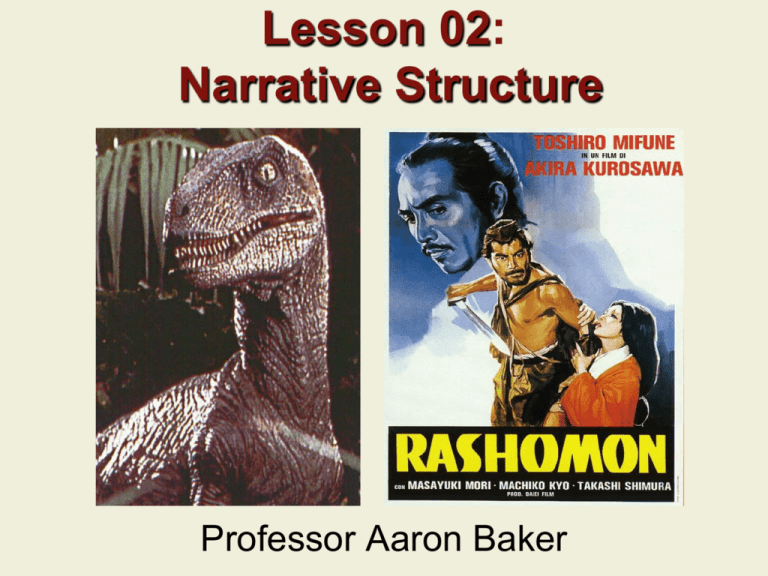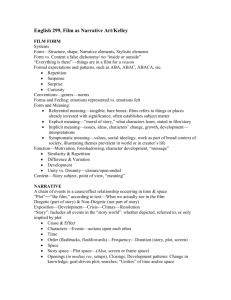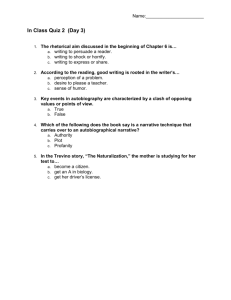Jurassic Park
advertisement

Lesson 02: Narrative Structure Professor Aaron Baker Previous Lecture • Course Requirements • Classic Hollywood Cinema • Invisible Style • Avoidance of Choice 2 This Lecture • Narrative Structure • Classical Hollywood Narrative Style • Jurassic Park (1993) and Citizen Kane (1941) • Japanese film Rashomon (1950) and Art Cinema Narration. 3 Part I: Narrative Structure 4 Narrative • “A chain of events in cause-effect relationship occurring in time and space” Film Art page 75. • A story 5 Structures Our Lives • Literature, History, Biography • Religion • TV, Films • Conversations • Even Dreams 6 Beginnings Set Up… • • • Themes Conflicts Questions What the story will be about. 7 Delay • Conclusions About Themes • Resolutions of Conflicts • Answers to Questions Otherwise the film would end too quickly. 8 Jurassic Park • A worker is killed in the first scene. • Theme established: recovering dinosaurs from extinction will be dangerous. • Then. . . 9 A Different Direction In Scene Two— • Lawyer & Scientist Discuss Investor Concerns • Finding a Mosquito Encased in Amber 10 Scene Two Raises New Questions • Let’s watch how the first two scenes set up new themes and questions and practice delay. • Please stop the lecture and watch the clip from the Learning Tasks page. Delay in Narrative • Necessary So Story Not Too Short • French critic Roland Barthes has said pleasure of stories from the process of getting to resolutions--as well as endings themselves. • In other words, delay enjoyable also! 12 Part II: Classical Hollywood Narrative Style 13 Four Main Characteristics: 1. One or a Few Main Characters 2. Definite Goals 3. Clear Cause and Effect Connections Between Events Moving Forward 4. Endings that Clearly Resolve Goals of Main Characters 14 Plot vs. Story Plot: Choices by filmmaker(s) of what story events to include in the movie and in what order. Story: Events plot present, plus those we infer or assume have occurred, in their causal relation, in chronological order (the order in which they happened). Jurassic Park • Attack in first scene happens after other events in the story such as the creation of the dinosaurs, and the planning of the park. • Starting with attack e.g. of plot manipulation. In Medias Res (in the middle of things) • Latin for how plot starts right in the action of the story • Jurassic Park’s opening • James Bond movies famous for starting in middle of action Flashbacks • Jump back into the past to events before those already shown • Explain why events happened Plot of Citizen Kane: • Starts at the end of the story (Charles Foster Kane’s death). • Then multiple flashbacks about the various ways Kane led his complex life. A Flashback from Kane Leland reflects on how Kane’s first marriage to Emily Norton fell apart. Please stop the lecture to watch the clip from the Learning Tasks page. Motif • A pattern of images and sounds in a film. • Two Kinds: Bound and Free • Bound: necessary to tell story • In Jurassic Park, the safety systems, because shutting them down directly bears on progress of plot. Free Motifs • Not Essential to Story • But Add Extra Thematic Meaning • The aerosol can Dennis uses for dinosaur embryos reinforces the theme of danger and greed. 22 Narrative Resolution • • • • • Goals Achieved Conflicts Solved Order; All Parts Fit Closure Happy Ending 23 In Hollywood Films Closure = Truth In Jurassic Park, this is achieved when Grant and Hammond agree the park isn’t safe. 24 Closure in Jurassic Park Communicates a larger truth: humans can’t totally control nature. 25 Part III: Art Film Narrative: Rashomon (1950) 26 Ambiguity • Goals, Conflicts • Cause/Effect of Action • In Rashomon, flashbacks offer contradictory accounts of rape and murder. • Active Viewer Required 27 Hollywood Objective Narration • Characters Words, Actions • Clear Cause and Effect 28 Clip from Jurassic Park • Narrative clearly presents words, actions • No Subjectivity • No Stylized Form • Please stop the lecture to watch a clip from the Learning Tasks page. 29 Art Film Subjective Narration • Shows Characters Subjectivity • Stylized Form Expresses Character’s Thoughts • Direct Address in Rashomon • Each Character’s Version of Crimes 30 Art Film • In contrast to Hollywood narrative, an art film like Rashomon may intentionally not have resolution or closure. • None of the flashbacks are privileged as true. 31 Why No Closure? • The art film isn’t a story unless well told. Rather, it operates with different assumptions about the possibility of solving the conflicts or answering the questions it raises. 32 Discussion Question • As you watch Jurassic Park, consider exactly what kinds of pleasure do we get from the plot practicing delay--not moving too quickly to resolution? • After viewing the film: Post responses on the eBoard to this question and the comment of a colleague. 33 Summary • Narrative Structure • Classical Hollywood Narrative Style • How Jurassic Park (1993) exemplifies Hollywood narrative style and how the Japanese film Rashomon (1950) illustrates art cinema narration. 34 End of Lecture 2 Next Lecture: Mise-en-Scene 35





